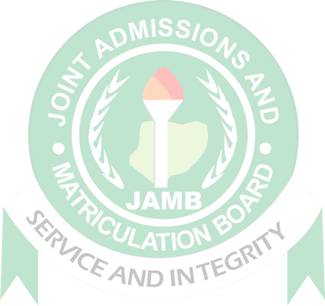
Mathematics (Core)
Paper 1 | Objectives | 50 Questions
JAMB Exam
Year: 2001
Level: SHS
Time:
Type: Question Paper
Answers provided
FREE
No description provided
Feedbacks
This paper is yet to be rated

Paper 1 | Objectives | 50 Questions
JAMB Exam
Year: 2001
Level: SHS
Time:
Type: Question Paper
Answers provided
No description provided
This paper is yet to be rated
Tips to make the best study space and quality time for studies are essential.
Try studying past questions since it's a sure way to better grades in any subject at school and beyond.
Make sure you study hard but not into the late-night hours to give your body the enough rest you need.
| # | Question | Ans |
|---|---|---|
| 1. |
Evaluate 21.05347 - 1.6324 x 0.43 to 3 decimal places A. 20.980 B. 20.351 C. 20.981 D. 20.352
Show Content
Detailed SolutionHint: Use BODMAS, in other words, do multiplication of the second and the last first before subtracting value obtained from the first. |
|
| 2. |
Simplify \((\sqrt[3]{64a^{3}})^{-1}\) A. 4a B. 1/8a C. 8a D. 1/4a
Show Content
Detailed Solution\((\sqrt[3]{64a^{3}})^{-1} = (\sqrt[3]{(4a)^{3}})^{-1}\)= \((4a)^{-1} \) = \(\frac{1}{4a}\) |
|
| 3. |
Given that \(p = 1 + \sqrt{2}\) and \(q = 1 - \sqrt{2}\), evaluate \(\frac{p^{2} - q^{2}}{2pq}\). A. 2(2+√2) B. -2(2+√2) C. 2√2 D. -2√2
Show Content
Detailed Solution\(\frac{p^{2} - q^{2}}{2pq} = \frac{(p + q)(p - q)}{2pq}\)= \(\frac{(1 + \sqrt{2} - (1 - \sqrt{2}))(1 + \sqrt{2} + 1 - \sqrt{2})}{2(1 + \sqrt{2})(1 - \sqrt{2})}\) = \(\frac{(2\sqrt{2})(2)}{-2}\) = \(-2\sqrt{2}\) |
|
| 4. |
A car dealer bought a second-hand car for N250,000 and spent N70,000 refurbishing it. He then sold the car for N400,000. What is the percentage gain? A. 60% B. 32% C. 25% D. 20%
Show Content
Detailed SolutionTotal cost = N(250,000 + 70,000) = N320,000Selling price = N400,000 (given) Gain = SP - CP = N(400,000 - 320,000) = N80,000 Gain % = gain/CP x 100 = (80,000/320,000) x 100 Gain % = 25% |
|
| 5. |
If \(x = \frac{y}{2}\),evaluate\(\left(\frac{x^{3}}{y^{3}}+\frac{1}{2}\right) \div \left(\frac{1}{2} - \frac{x^{2}}{y^{2}}\right)\) A. 5/8 B. 5/2 C. 5/32 D. 5/16
Show Content
Detailed Solution\(x = \frac{y}{2} \)\(\left(\frac{x^{3}}{y^{3}}+\frac{1}{2}\right) \div \left(\frac{1}{2} - \frac{x^{2}}{y^{2}}\right)\) \(\frac{x^3}{y^3} + \frac{1}{2} = (\frac{y}{2})^{3} \div y^{3} + \frac{1}{2}\) = \(\frac{y^{3}}{8} \times \frac{1}{y^3} + \frac{1}{2}\) = \(\frac{1}{8} + \frac{1}{2}\) = \(\frac{5}{8}\) \(\frac{1}{2} - \frac{x^2}{y^2} = \frac{1}{2} - (\frac{y}{2})^{2} \div y^2)\) = \(\frac{1}{2} - \frac{y^2}{4} \times \frac{1}{y^2}\) = \(\frac{1}{2} - \frac{1}{4}\) = \(\frac{1}{4}\) \(\therefore \left(\frac{x^{3}}{y^{3}}+\frac{1}{2}\right) \div \left(\frac{1}{2} - \frac{x^{2}}{y^{2}}\right) = \frac{5}{8} \div \frac{1}{4}\) = \(\frac{5}{2}\) |
|
| 6. |
Find the principal which amounts to N5,500 at a simple interest in 5 years at 2% per annum. A. N4,900 B. N5,000 C. N4,700 D. N4,800
Show Content
Detailed SolutionPrincipal, P = Amount, A - Interest, I.A = P + I I = (P.T.R)/100 = (P x 5 x 2)/100 = 10P/100 = P/10 But A = P + I, => 5500 = P + (P/10) => 55000 = 10P + P => 55000 = 11P Thus P = 55000/11 = N5,000 |
|
| 7. |
Evaluate \(\frac{(0.14^2 \times 0.275)}{7(0.02)}\) to 3 decimal places. A. 0.039 B. 0.385 C. 0.033 D. 0.038
Show Content
Detailed Solution\(\frac{(0.14)^{2} \times 0.275}{7(0.02)} = \frac{(0.14)^{2} \times 0.275}{0.14}\)= \(0.14 \times 0.275\) = \(0.0385 \approxeq 0.039\) |
|
| 8. |
Divide: \(a^{3x} - 26a^{2x} + 156a^{x} - 216\) by \(a^{2x} - 24a^{x} + 108\). A. ax - 2 B. ax + 2 C. ax - 8 D. ax - 6
Show Content
Detailed Solution\(\frac{a^{3x} - 26a^{2x} + 156a^{x} - 216}{a^{2x} - 24a^{x} + 108}\)Let \(a^{x} = z\) \(\therefore = \frac{z^{3} - 26z^{2} + 156z - 216}{z^{2} - 24y + 108} ... (i)\) Dividing (i) above, we get \(z - 2\) = \(a^{x} - 2\) |
|
| 9. |
If two graphs y = px\(^2\) + q and y = 2x\(^2\) -1 intersect at x = 2, find the value of p in terms q. A. \(\frac{q-8}{7}\) B. \(\frac{7-q}{4}\) C. \(\frac{8-q}{2}\) D. \(\frac{7+q}{8}\)
Show Content
Detailed Solution\(y = px^{2} + q ... (i)\)\(y = 2x^{2} - 1 ... (ii)\) At x = 2, (i): \(y = p(2^{2}) + q = 4p + q\) (ii): \(y = 2(2^{2}) - 1 = 7\) \(\therefore \text{The coordinates of the point of intersection = (2, 7)}\) (i): \(7 = 4p + q \implies p = \frac{7 - q}{4}\) |
|
| 10. |
Find the integral values of x and y satisfying the inequality 3y + 5x \(\leq\) 15, given that y > 0, y < 3 and x > 0. A. (1,1), (1,2), (1,3) B. (1,1), (2,1), (1,3) C. (1,1), (3,1), (2,2) D. (1,1), (1,2), (2,1)
Show Content
Detailed SolutionHint: Sketch the inequality graph for the 3 conditions given and read out your points from the co-ordinates. |
Preview displays only 10 out of the 50 Questions